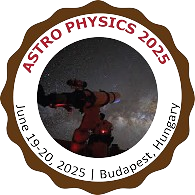About Conference
The Astro Physics 2025: 8th International Conference on Astronomy, Astrophysics, and Space Science is set to take place on June 19-20, 2025, in the historic city of Budapest, Hungary. This premier event will bring together leading astronomers, astrophysicists, space scientists, and industry experts from around the globe to discuss the latest advancements and innovations in these exciting fields.
The conference aims to provide a platform for researchers, academicians, and professionals to share their groundbreaking research findings, explore new theories, and engage in thought-provoking discussions on a wide array of topics. Key themes include black hole physics, cosmology, stellar evolution, planetary science, and space exploration technologies.
Attendees will have the opportunity to participate in a diverse range of sessions, including keynote speeches from renowned experts, panel discussions, workshops, and poster presentations. These sessions are designed to foster collaboration, inspire new research directions, and address the challenges and opportunities in the rapidly evolving landscape of space science.
In addition to the formal sessions, the conference will offer ample networking opportunities, allowing participants to connect with peers, establish collaborations, and exchange ideas in an informal setting. The vibrant city of Budapest, with its rich cultural heritage and stunning architecture, will provide a picturesque backdrop for the event, enhancing the overall experience for attendees.
Astro Physics 2025 promises to be a landmark event, driving forward the frontiers of astronomy, astrophysics, and space science, and paving the way for future discoveries and innovations in these fascinating fields.
Scientific Sessions & Tracks
Cosmology and the Early Universe
Cosmology studies the universe's origin, structure, evolution, and eventual fate. The early universe, moments after the Big Bang, was hot, dense plasma of particles. As it expanded, it cooled, leading to the formation of atoms, stars, and galaxies. Key discoveries include cosmic microwave background radiation, dark matter, and dark energy. These findings help unravel the universe's mysteries and our place within it.
Stellar Astrophysics
Stellar astrophysics explores the life cycles of stars, from formation in molecular clouds to end states like white dwarfs, neutron stars, or black holes. It examines nuclear fusion processes powering stars, their chemical compositions, and luminosity variations. Key tools include spectroscopy and astrophysical models, helping understand stellar evolution, the role of stars in galaxy formation, and their influence on the cosmic environment.
Solar and Space Physics
Solar and space physics explores the Sun's impact on space and Earth, studying solar wind, magnetic fields, and cosmic rays. Key topics include solar flares, geomagnetic storms, and space weather effects on satellites and communication systems. Understanding these phenomena is crucial for protecting technology and infrastructure, advancing scientific knowledge, and ensuring the safety of space missions and astronauts.
High-Energy Astrophysics
High-energy astrophysics studies celestial phenomena involving extreme energy levels, such as black holes, neutron stars, and supernovae. It focuses on X-rays, gamma rays, and cosmic rays, providing insights into the universe's most violent and energetic processes. Advanced telescopes and detectors enable scientists to explore these high-energy events, unveiling the dynamics of particle acceleration, magnetic fields, and the fundamental laws governing the cosmos.
Planetary Science and Exploration
Planetary Science and Exploration delve into understanding celestial bodies, their formation, evolution, and potential for life. It involves studying planets, moons, asteroids, and comets through missions and telescopic observations. Key focuses include Mars exploration, the search for exoplanets, and understanding Earth's place in the universe. These endeavors enhance our knowledge of solar system dynamics, planetary atmospheres, and the potential for future human exploration.
Astrophysical Plasmas
Astrophysical plasmas, comprising ionized gases in space, are critical to understanding cosmic phenomena. These plasmas, found in stars, interstellar medium, and galaxies, exhibit unique behaviors due to their high energy and magnetic fields. They drive processes like solar flares and stellar formation. Studying these plasmas reveals insights into the universe's evolution, cosmic ray propagation, and the dynamics of celestial objects.
Astrophysics of Compact Objects
Astrophysics of compact objects explores celestial bodies like neutron stars, black holes, and white dwarfs. These objects are remnants of stellar evolution, characterized by extreme densities and strong gravitational fields. Neutron stars are incredibly dense, while black holes exhibit intense gravity so strong that not even light can escape. White dwarfs are the cooled cores of dead stars. Studying them reveals insights into fundamental physics and cosmic evolution.
Observational Astronomy
Observational astronomy involves studying celestial objects and phenomena through direct observation. By using telescopes and other instruments, astronomers analyze the light and other signals emitted by stars, planets, and galaxies. This branch of astronomy helps us understand the universe's structure, origins, and evolution. Observational techniques include photometry, spectroscopy, and astrometry, each offering insights into different aspects of cosmic objects and their behavior.
Gravitational Wave Astronomy
Gravitational wave astronomy detects ripples in spacetime caused by massive cosmic events, like merging black holes or neutron stars. These waves, predicted by Einstein's General Theory of Relativity, offer a novel way to observe the universe, unveiling phenomena invisible through traditional methods. By analyzing these waves, scientists gain insights into the universe's most violent and energetic processes, enriching our understanding of cosmic evolution and fundamental physics.
Astrochemistry
Astrochemistry explores the chemical processes and compounds in space, bridging chemistry and astronomy. It investigates the formation of molecules in interstellar clouds, star-forming regions, and planetary atmospheres. Key topics include the synthesis of organic molecules in space, the role of dust and ice in chemical reactions, and the conditions leading to complex organic compounds. Astrochemistry helps us understand the origins of life and the chemical diversity of the universe.
High-Redshift Universe
The high-redshift universe reveals the early cosmos, where galaxies and structures formed shortly after the Big Bang. Observations of high-redshift objects help us understand the universe's infancy, its expansion rate, and the formation of the first stars and galaxies. This research offers insights into cosmic evolution, dark matter, and dark energy, reshaping our understanding of the universe's origins and its early development.
Quantum Astrophysics
Quantum astrophysics explores the intersection of quantum mechanics and astrophysics, revealing how subatomic particles and quantum fields influence cosmic phenomena. It delves into the behavior of black holes, the early universe, and dark matter, integrating quantum principles with general relativity. By understanding quantum fluctuations and particle interactions in extreme environments, this field aims to unravel mysteries of the universe’s origins, structure, and fundamental forces.
Astroparticle Physics
Astroparticle physics explores the intersection of particle physics and astrophysics, studying cosmic particles like neutrinos, cosmic rays, and dark matter. By analyzing these particles, scientists uncover fundamental aspects of the universe, including its origins, structure, and the nature of dark matter and dark energy. This field combines experimental techniques from both disciplines to investigate phenomena beyond the reach of traditional particle accelerators and telescopes.
Exoplanet Atmospheres
Exoplanet atmospheres offer insights into planetary composition and potential habitability. Key elements include studying atmospheric pressure, temperature, and chemical makeup. Techniques like transit spectroscopy analyze light passing through an exoplanet’s atmosphere, revealing gases such as water vapor, methane, and carbon dioxide. This research helps identify potentially habitable worlds and understand atmospheric processes, enhancing our knowledge of planetary systems beyond our solar system.
Space Telescopes and Missions
Space telescopes, like Hubble and James Webb, revolutionize our understanding of the universe. Hubble has captured stunning images of distant galaxies, while Webb, with its advanced infrared capabilities, explores the universe's earliest galaxies and star systems. Missions like these expand our knowledge of cosmic phenomena, from star formation to the nature of dark matter, revealing the universe's intricate beauty and complexity.
Radio Astronomy
Radio astronomy is the study of celestial objects through their radio frequency emissions. Unlike optical astronomy, which relies on visible light, radio astronomy detects signals from distant stars, galaxies, and other cosmic phenomena. By analyzing these radio waves, scientists can uncover details about the universe’s structure, composition, and dynamics, revealing phenomena like pulsars, quasars, and cosmic microwave background radiation. It provides crucial insights into the universe’s evolution and behavior.
Astrophysical Magnetic Fields
Astrophysical magnetic fields play a crucial role in shaping cosmic phenomena. They influence star formation, drive jets and outflows from black holes, and affect the behavior of interstellar and intergalactic matter. Magnetic fields are integral to the dynamics of accretion disks around celestial objects and contribute to the structure of galaxies. Studying these fields helps us understand the forces governing the universe's large-scale structure and evolution.
Relativistic Astrophysics
Relativistic astrophysics explores cosmic phenomena where gravity and velocity approach the speed of light. Key topics include black holes, where intense gravity warps spacetime, and neutron stars, which are super-dense remnants of stellar explosions. The study also covers gravitational waves, ripples in spacetime from massive collisions, and the impact of relativity on light and time. This field deepens our understanding of the universe's extreme environments.
Astrophysical Turbulence
Astrophysical turbulence is a chaotic flow of plasma and gases in cosmic environments like stars, galaxies, and interstellar space. It affects star formation, cosmic ray propagation, and energy distribution. Understanding this turbulence helps in modeling the behavior of astrophysical systems, revealing insights into galaxy evolution and stellar dynamics. Advanced simulations and observations are crucial for grasping how turbulence influences the structure and evolution of the universe.
Polarization in Astrophysics
Polarization in astrophysics refers to the alignment of light waves in specific directions as they travel through space. This phenomenon helps scientists probe the magnetic fields, dust, and gases in celestial objects. By studying polarized light from stars, galaxies, and cosmic dust, researchers can gain insights into the structure of magnetic fields, the nature of interstellar dust, and the formation of cosmic structures.
Space Mission Operations and Management
Space Mission Operations and Management involve planning, executing, and overseeing space missions to ensure objectives are met efficiently. Key aspects include mission design, scheduling, resource allocation, risk management, and real-time monitoring. Effective operations integrate advanced technologies, skilled teams, and strategic decision-making. Success relies on meticulous coordination between ground control and spacecraft, as well as adaptability to unforeseen challenges, ensuring mission goals are achieved safely and effectively.
Supernova Remnants
Supernova remnants (SNRs) are the expanding debris left after a massive star explodes in a supernova. They consist of a hot, ionized gas and dust ejected from the stellar explosion. SNRs play a crucial role in the cosmic cycle, enriching the interstellar medium with heavy elements, and they can trigger new star formation. Notable examples include the Crab Nebula and Cassiopeia A.
Solar System Dynamics
Solar System Dynamics studies the gravitational interactions among celestial bodies within our solar system. It involves understanding the orbits of planets, moons, asteroids, and comets, and how these paths are influenced by gravitational forces from the Sun and other bodies. This field uses mathematical models and simulations to predict orbital changes, system stability, and potential impacts, offering insights into phenomena like planetary migrations and long-term orbital evolution.
Instrumentation and Technology Development
Instrumentation and technology development are crucial for advancing scientific research and industry. Cutting-edge tools enhance precision, efficiency, and data collection capabilities. Innovations such as advanced sensors, automation, and data analytics enable real-time monitoring and control, driving progress in fields like healthcare, manufacturing, and environmental science. Staying abreast of these developments ensures improved performance, accuracy, and the ability to tackle complex challenges effectively.
Abstract Submission Criteria & Eligibility
PRESENTATION REQUIREMENTS:
Authors presenting at the conference are required to cover their own registration, travel, and accommodation expenses. Please note that accepted abstracts will receive an acceptance email with instructions on how to register for the conference.
Abstracts will be compiled into conference books, which will be distributed to participants during the event.
In the event that a presenter is unable to attend, they must arrange for a qualified substitute to present their paper or poster. If such a change is needed, please notify our conference team promptly.
SUBMISSION OPTIONS:
Oral paper presentations will be allocated 30-minute time slots and will be organized into sessions based on thematic clustering. The keynote session will extend for 45 minutes, while workshops/special sessions will have duration of 60 minutes. Symposia will also be allotted 60 minutes, followed by a 5-minute Q&A session.
Graduate and Master’s students may submit their abstracts for consideration in the poster and e-poster presentation category.
PhD students are invited to submit abstracts for the special Young Researcher’s Forum (YRF), poster, and e-poster presentation category. It's important to note that the YRF category encompasses brief oral presentations specifically tailored for Ph.D. students.
Extended abstract: Here's a revised version of the instructions in the Abstract Template format:
Title: Submissions Utilizing the Abstract Template
Abstract: This abstract outlines the requirements for submissions utilizing the Abstract Template in the specified category. Papers submitted in this category may encompass original empirical research, theoretical development, reviews, or critiques. The format ensures consistency and clarity in presentation, facilitating comprehension and evaluation for reviewers and readers alike.
Keywords: Abstract Template, submissions, empirical research, theoretical development, reviews, critiques.
These abstracts follow the structure of the Abstract Template, providing a concise overview of the respective topics while adhering to the prescribed format.
Participation/Presentation Option
Oral presentation: Oral presentations are open to topics spanning research, theory, professional practices, or personal experiences, presented in a succinct manner. Individuals with personal insights are encouraged to share narratives aiding everyday life. Speakers allotted a 30-minute slot should aim for a speaking duration of 20-25 minutes, while Keynote speakers should target 40-45 minutes, reserving the remainder for questions and discussion facilitated by the Session Chair.
Workshop: Workshop presenters will cover the same topic as the oral presentation but delve deeper into specialized techniques with detailed demonstrations. The workshop will last approximately 45-50 minutes, allowing for in-depth exploration. Participants keen on joining can do so alongside their teams, collaborating with their research coordinators. Special group waivers will be available upon registration for these workshops.
Poster presentation: The Astro Physics 2025 conference will be hosting a Student Poster Competition, aiming to foster the presentation of original research by students and recent graduates. Each presenter will have approximately 5-7 minutes to present their poster, which includes time for questions and answers. During the evaluation process, judges may pose questions to the presenters. This competition serves as an invaluable opportunity for emerging scientists to engage with the latest research in their field and enhance their skills as multidisciplinary researchers. Poster displays will be in hard copy format, measuring 1x1 meter.
For further information on Poster Presentation and Judging Criteria, please refer to the Poster Presentation Guidelines.
Webinar: The webinar presentation caters to interested attendees unable to participate in person due to scheduling conflicts or other commitments. In this alternative, the presenter can pre-record their session, which will then be featured during the webinar presentation session.
E-Poster: The e-Poster shares similarities with webinar presentations. During this session, participants will showcase their presentations in a poster format on the conference website. Additionally, the presenter's abstract will be featured in the conference souvenir and journal, complete with a DOI (Digital Object Identifier).
Exhibition: You're invited to participate in Astro Physics 2025, an event showcasing products and services from various organizations including drug manufacturers, clinical trial sites, management consultants, chemists, pharmacists, business delegates, and equipment manufacturers—both commercial and non-commercial.
Discover booth details and benefits by visiting "Why Exhibit with Us?" For further inquiries, reach out to contact@europeanmeets.com.
Advertisement: We are delighted to extend a warm welcome to all esteemed participants to the upcoming “8th International Conference on Astronomy, Astrophysics and Space Science," slated for June 19-20, 2025 in Budapest, Hungary. Our conference program serves as an indispensable guide throughout the event, providing invaluable information for attendees as they navigate the sessions and networking opportunities.
Advertising within the conference program presents a prime opportunity to showcase your brand and services to a targeted audience, ensuring maximum visibility and long-term business prospects. Explore our diverse range of advertisement options and competitive prices by reaching out to us at contact@primecongress.com.
Moreover, consider elevating your presence and demonstrating your commitment to the field through our Premium Sponsorship package or explore additional sponsorship opportunities tailored to your preferences. For more details on our sponsorship packages, kindly contact our program manager at contact@europeanmeets.com or reach out via WhatsApp at +44-2045861247.
Join us as we convene leading experts, researchers, and professionals to exchange insights, foster collaborations, and advance the fight against Astronomy, Astrophysics and Space Science. We look forward to your participation in shaping this transformative event.
Young Research Award
Prestigious Award for Young Research’s at Astro Physics 2025 – “Astronomy, Astrophysics and Space Science”
Astro Physics 2025 Committee is glad to announce “8th International Conference on Astronomy, Astrophysics and Space Science” on June 19-20, 2025 in Budapest, Hungary focusing on the theme: “Exploring the Cosmos: Innovations and Discoveries in Astronomy, Astrophysics, and Space Science” Astro Physics 2025 developments are maintaining their momentum. Astronomy, Astrophysics, and Space Science Conference program delves into strategic discussions.
Astro Physics 2025 Young Scientist Awards:
Astro Physics 2025 Committee is intended to honour prestigious award for talented Young researchers, scientists, Young Investigators, Post-Graduate students, Post-doctoral fellows, Trainees, Junior faculty in recognition of their outstanding contribution towards the conference theme. The Young Scientist Awards make every effort in providing a strong professional development opportunity for early career academicians by meeting experts to exchange and share their experiences on all aspects of Astronomy, Astrophysics and Space Science.
Young Research’s Awards at Astro Physics 2025 for the Nomination: Young Researcher Forum - Outstanding Masters/Ph.D./Post Doctorate thesis work Presentation, only 25 presentations acceptable at Astro Physics 2025 young research forum.
Benefits
Young Scientist Award recombination certificate and memento to the winners.
Our conferences provide best Platform for your research through oral presentations.
Learn about career improvement with all the latest technologies by networking.
Young Scientists will get appropriate and timely information by this Forum.
Platform for collaboration among young researchers for better development.
Provide an opportunity for research interaction and established senior investigators across the globe in the field.
Share the ideas with both eminent researchers and mentors.
It’s a great privilege for young researchers to learn about the research areas for expanding their research knowledge.
Eligibility
Young Investigators, Post-Graduate students, Post-doctoral fellows, Trainees, junior faculty with a minimum of 5 years of research experience
Presentation must be into scientific sessions of the conference.
Each Young Researcher / Young Scientist can submit only one paper (as first author or co-author).
Age limit-Under 35yrs
All submissions must be in English.
Market Analysis
The graph above illustrates the projected market growth for Astronomy, Astrophysics, and Space Science from 2020 to 2025. Here are the key points highlighted in the analysis:
-
Steady Growth:
-
The market value for Astronomy, Astrophysics, and Space Science has been on a consistent upward trajectory over the past few years.
-
In 2020, the market was valued at $2.5 billion USD.
-
By 2025, it is projected to reach $5.5 billion USD, more than doubling its value over five years.
-
Yearly Increments:
-
2020: $2.5 billion
-
2021: $3.0 billion
-
2022: $3.6 billion
-
2023: $4.2 billion
-
2024: $4.9 billion
-
2025: $5.5 billion
-
Increasing investment in space exploration and related technologies.
-
Advancements in astronomical research and technology.
-
Growing interest in space tourism and commercial space flights.
-
Enhanced governmental and private funding for space science projects.
-
The upward trend signifies a robust and expanding market, offering numerous opportunities for researchers, scientists, and businesses involved in these fields.
-
Stakeholders can expect continued growth, driven by innovation and expanding applications of space science and technology.
-
The consistent market growth from 2020 to 2025 indicates a thriving sector with promising future prospects.
-
This trend underscores the importance and impact of Astronomy, Astrophysics, and Space Science on the global economy and technological advancement.
-
Factors Driving Growth:
-
Implications:
-
Conclusion:
This analysis highlights the dynamic nature of the Astronomy, Astrophysics, and Space Science market, demonstrating its resilience and potential for sustained growth.












